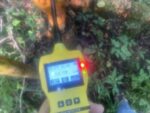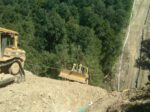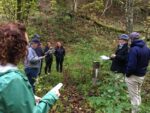- Like
- Digg
- Del
- Tumblr
- VKontakte
- Buffer
- Love This
- Odnoklassniki
- Meneame
- Blogger
- Amazon
- Yahoo Mail
- Gmail
- AOL
- Newsvine
- HackerNews
- Evernote
- MySpace
- Mail.ru
- Viadeo
- Line
- Comments
- Yummly
- SMS
- Viber
- Telegram
- Subscribe
- Skype
- Facebook Messenger
- Kakao
- LiveJournal
- Yammer
- Edgar
- Fintel
- Mix
- Instapaper
- Copy Link
Above is a 29-minute video of a guided Tour of Gas Wells & Their Problems in Kanawha State Forest recorded in November of 2023. The 9000-acre Kanawha State Forest is technically a state “forest”, but after citizen complaints to the Legislature about logging there, it is now managed as a state park.
The video starts with a brief history of the Forest, and then a brief history of gas well drilling in the Forest. The drilling in the Forest has all been conventional, vertical gas wells to sandstone formations — and not the drilling of horizontal, shale wells that are now the only wells drilled anywhere in West Virginia. Importantly, the issues of how the vertical portions of the wells are drilled, how wells are plugged, and the problems leading to un-plugged orphaned wells are the same for both types of wells.
The tour itself starts by going to an example of a properly maintained well that is still producing in paying quantities. There the tour briefly explains well drilling and explains the facilities for production from the well that are above ground.
Next comes a leaking fixture on a gathering pipeline.
Then the tour goes to a leaking, unplugged, non-producing and therefore statutorily “abandoned” well that should already by law have been plugged. This well has a “responsible operator” that is still in business but has not plugged the well. This well is one of over 1000 wells under that operator’s meager statutory “blanket” bond of $50,000.
Next the tour goes to a well that appears to have been properly plugged. Whether the well actually was properly plugged could only be determined if it was inspected during the plugging process activities because the plugging work, or lack of it, is now buried under the ground.
(There is also a brief look at the collapsed entrance to a pre-1907 drift coal mine that was punched horizontally into the side of a mountain and was then abandoned.)
The tour concludes with three “orphaned” gas wells in the Forest that have gone unplugged for so long that their driller/operator has gone out of business — leaving the well to be plugged by the surface owner or by the State with what money the State may have to plug orphaned wells.
Please enjoy the video tour and contact us if you have any questions.
West Virginia Surface Owner’s Rights Organization holds the copyright. Permission is given to share the video, but only by sharing the link to this page and not directly to the video — and only for no charge.
We welcome donations to help with our work! Or join us to get our annual newsletter and alerts about legislative activity.
For more detailed information on how an oil or gas well is drilled into the ground and what can go wrong, the tour refers to a slide show on the website of the West Virginia Surface Owner’s Rights Coalition. Here is a link to that slide show.
The tour also refers to a web page on WVSORO’s website that shows why an old well is plugged, not “capped”; and how a well is supposed to be plugged; and why a lot of oversight of well pluggers is needed. Here is a link to that slide show.
Listen here for the song that starts and ends the video in its entirety, THE WEST VIRGINIA LAND REUNION SONG.
Additional Information and Errata
At 1:43 the Civilian Conservation Corps also built a superintendent residence, a temporary dam and other features in addition to the picnic shelters.
At 1:48 the metal casing that was mentioned should be left in the ground until the well was properly plugged with clay and cement.
At 3:33 other shales are also being horizontally drilled such as the Utica and some day the Rogersville.
At 5:04 the wells referred to are actually operating drilling rigs for wells, and during the drilling of a well there are two very important times when the inspector should be there and other times when it is advisable for the inspector to be there in order to protect ground water, coal seams etc.
At 5:14 it should be noted that the State has no obligation to plug orphaned wells. Although the surface owner as well as the coal owner and others have the right to plug the well and recoup the cost from the well driller/operator, few surface owners have the cash flow to pay the plugging cost, and the cost of a law suit to recoup the plugging cost is expensive — if the operator is still in business and has any assets from which to collect.
At 5:46 the new technology mentioned is not just the high volume frac’ing but the horizontal drilling technology, now up to three miles.
At 6:26 conventional vertical wells are drilled not only to sandstones but to limestones.
At 7:26 climate change is caused by a lot more other atmospheric releases than methane though methane is one of the most potent.
At 8:00, the phrase “return to the surface” means that enough cement was pushed down the inside of the metal pipe casing to go to the bottom and then be pushed up the outside of the casing (between the outside of the metal casing and the inside of the well bore) so that there was enough cement to cement the metal casing in the hole all the way back to the surface. This would ensure that groundwater etc. all the way to the top was cemented off from the gas in the well bore once the well started producing and from contamination from other strata such as iron and sulphur water. A number of things could cause the cement not to make it back up as explained in the slide show about drilling a gas well noted above.
At 10:32 the gas that comes out would be gas that powered the push of brine water from the separator to the collection tank. That gas is vented to the atmosphere by the process. Under pressure, the industry is moving to techniques that do not use the pressure and subsequent release of gas to power production activities.
At 12:52 the water that is discussed as the water that can get collected inside the dike is rainwater, and the holes created by crawdad’s that like the wet ground can go down and then tunnel under the dike to cause leaks outside the dike if there is a large leak out of the tank.
At 13:38 the disclosures regarding plugging made by Diversified to its shareholders in Great Britain are that Diversified has made deals with state agencies that limit the state’s current plugging enforcement against Diversified. So instead of spending more money now plugging, Diversified can pay dividends. As those 10,000 unplugged wells start to need plugging, there will be no money to plug them because the wells Diversified owns will no longer be profitable even to operate themselves, let alone pay for their plugging.
At 14:00 the production line is more commonly referred to as a “gathering” line which will then lead to a transmission line (though the dividing line between those two is blurred) and then eventually to a distribution line to homes and businesses.
At 16:00 it is explained that at 100 parts per million hydrogen sulphide burns out peoples noses so they can no longer smell it. It would take un-smelled concentrations of 700 to 1000 parts per million to actually kill a person quickly. However, there are allegations now that long term low levels of H2S leaks may have an adverse effect on health of those living nearby. No one actually lives nearby this leak fortunately.
At 18:03 note that when a complaint was made to Diversified about this leak, workers came out and applied a sealant to the joints and there is no longer an odor here.
At 18:55 the gun shots that can be heard are because this well is near the Kanawha State Forest public shooting range and as this was filmed hunting season was approaching.
At 21:20 bentonite gel is actually bentonite clay — which in granulated form is used a kitty litter.
At 23:00 calling the 75,000+ wells that the DEP has in its database “active” is not the best term. Many of them are not producing. Some of them are even plugged though even those can need attention. But it is a fair gross number to use to make the point about the lack of inspectors, particularly considering the thousands of wells on the West Virginia Geological and Economic Survey data base that are not included in the 75,000 number.








